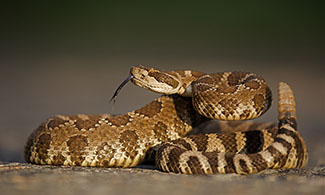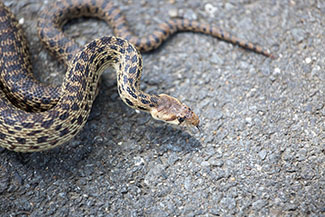Is That Snake Dangerous or Not?
How to 'Handle' Snakes in Your Backyard
To begin with, you don't really want to handle snakes. More likely, you want to keep them out of your yard as much as possible so you don't run into them. The season when you are most likely to see them runs from about April until Thanksgiving.
And as for "good" vs. "bad," all snakes play a beneficial role in maintaining the balance of nature in the desert. They control the populations of rabbits and desert rats, for example.
The "Bad" Snakes
 If you live in a less populated area, next to native desert or open space, you might encounter snakes more frequently, including the venomous rattlesnakes with the rattles on their tails. According to Arizona Game and Fish Department, 13 species of rattlesnakes in the state and four species are "protected." So, you don't want to kill those protected ones, but obviously, most of us couldn't identify which are protected and which are not.
If you live in a less populated area, next to native desert or open space, you might encounter snakes more frequently, including the venomous rattlesnakes with the rattles on their tails. According to Arizona Game and Fish Department, 13 species of rattlesnakes in the state and four species are "protected." So, you don't want to kill those protected ones, but obviously, most of us couldn't identify which are protected and which are not.
So, here are ideas for controlling contact with "bad" snakes:
Install snake fences
Perhaps the best solution is to install a snake fence to stop entrance to areas of your yard next to open land. If you have a concrete block fence with metal rails in it, for example, screens with a fine metal mesh can be attached to the rails with screws. The screens themselves or the wall should be buried into the ground to keep animals from digging under it.
Close the garage door
By keeping the garage door open, you provide easy access to snakes. So, don't leave the door open at night or day and make sure that when the door shuts there are no gaps in the door's seal. A snake might try to use that tiny hole to squeeze through. In some areas, homeowners report that snakes seem to enter the garage in the fall while hunting for a place to hibernate. It's also important to clean up a garage so rodents aren't likely to pay a visit and make a nest that will attract snakes. Be careful in hunting through boxes of junk in the garage. A snake might be hiding in that box.
If you meet a rattlesnake in the yard or garage
If you live in an area where you've seen snakes before, it's a good idea to be prepared in advance with the phone number for a commercial snake relocation expert. Or check online for a local herpetological society.
Sometimes, the local fire department may remove snakes or provide you with advice. Sometimes security guards in gated communities or personnel at golf courses will remove snakes and relocate them to a better habitat.
While waiting for help, don't disturb the snake, but remember where you last saw it and where it might be hiding.
If you're bitten get help as quickly as you can
The Mayo clinic advises that you call 911 or an emergency room number whether a child or an adult is bitten. Many ERs stock antivenom drugs. Before help arrives, stay calm and remove jewelry and tight clothing. Position yourself so the bite is at or below the level of your heart. Clean the wound but don't flush it with water. Don't suck out the venom and don't use a tourniquet or apply ice. Don't drink caffeine or alcohol. And don't try to capture the snake. Dogs or cats bitten by a snake need emergency treatment by a veterinarian.
The "Good" Snakes
Study up on snakes
 One big problem with snakes in Arizona is that many non-venomous snakes resemble the poisonous ones. What people call a "gopher" snake can look just like a diamondback, but has no rattles on its tail. Try to familiarize yourself with what those harmless snakes look like vs. what the venomous type are like. Reportedly, even non-poisonous snakes can bite; in those cases, call 911 as well.
One big problem with snakes in Arizona is that many non-venomous snakes resemble the poisonous ones. What people call a "gopher" snake can look just like a diamondback, but has no rattles on its tail. Try to familiarize yourself with what those harmless snakes look like vs. what the venomous type are like. Reportedly, even non-poisonous snakes can bite; in those cases, call 911 as well.
Always be cautious
Perhaps you're not worried about seeing snakes in the yard. But remember that it can be startling to see one unexpectedly wiggle across the sidewalk whether it is poisonous or not. So, cutting down snakes' access to your property might be the best idea. Snakes of any kind can also startle and upset children or pets.
May Home Maintenance To-Do | #GoodSnakeBadSnake
###
